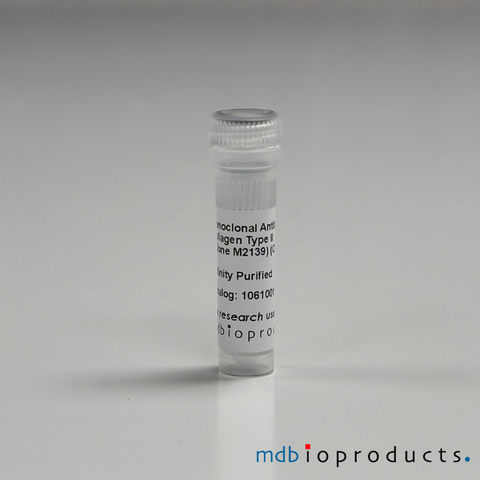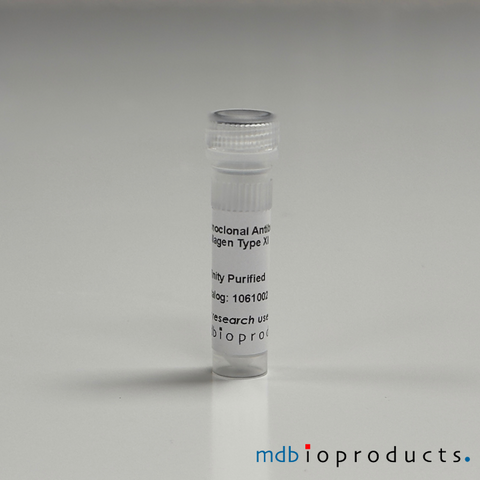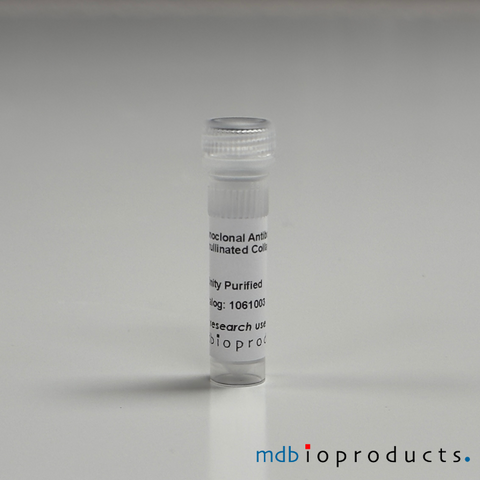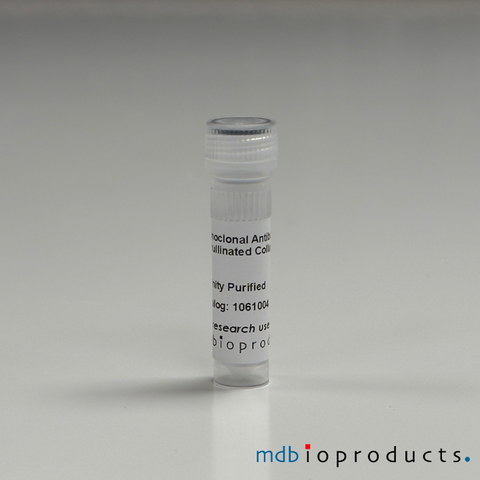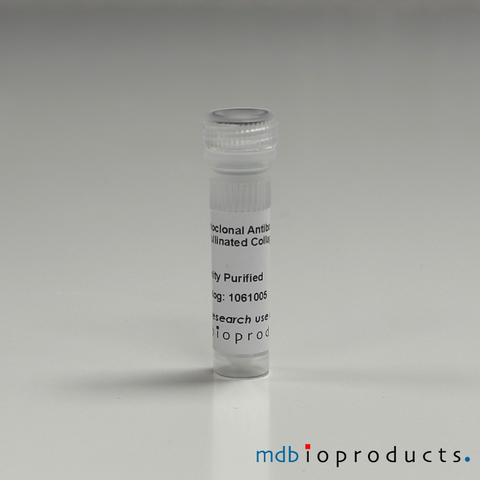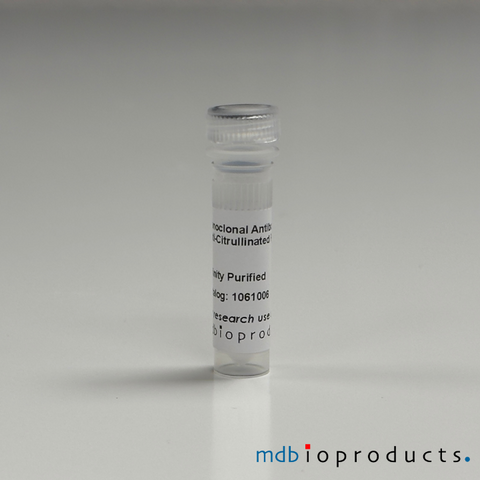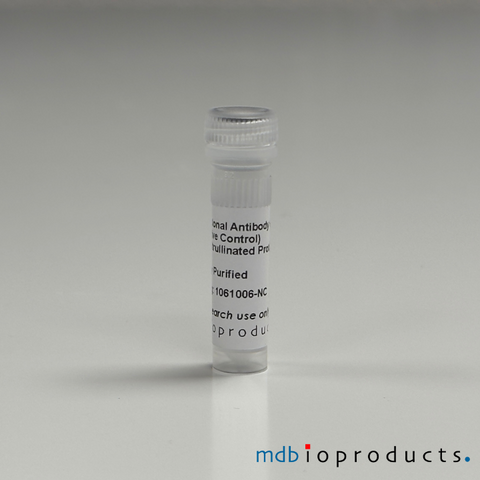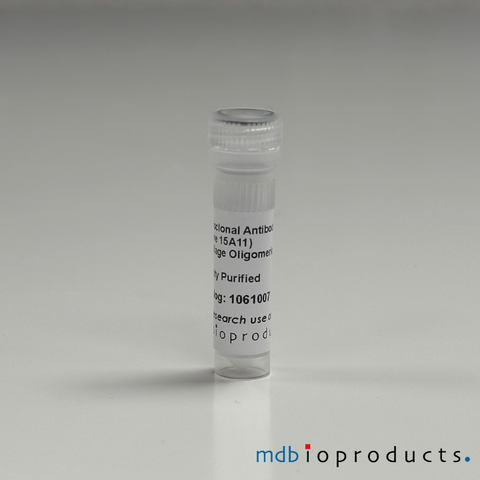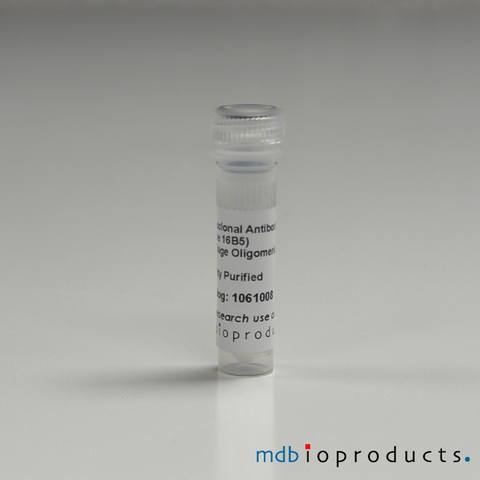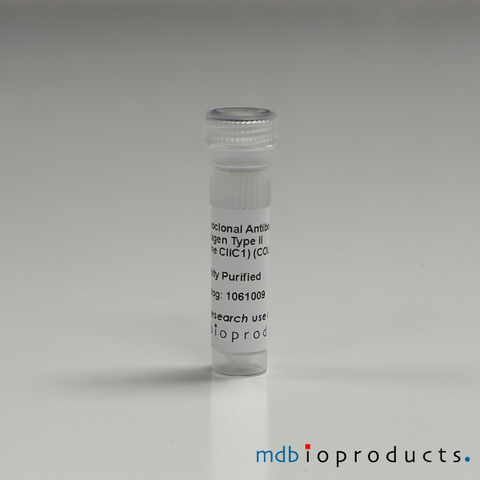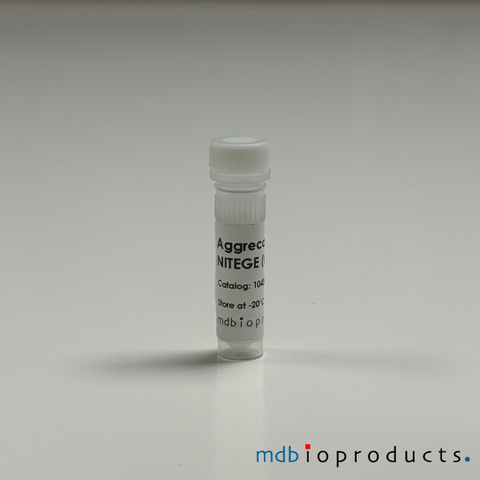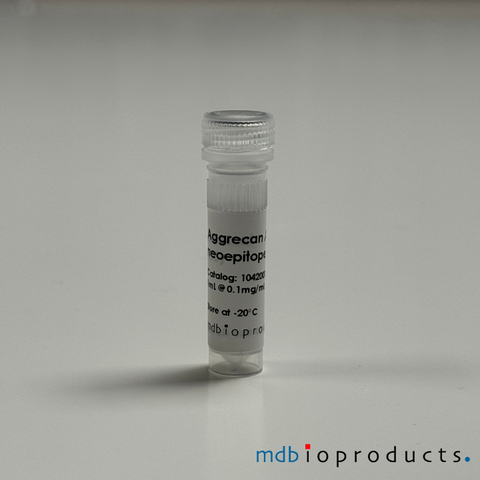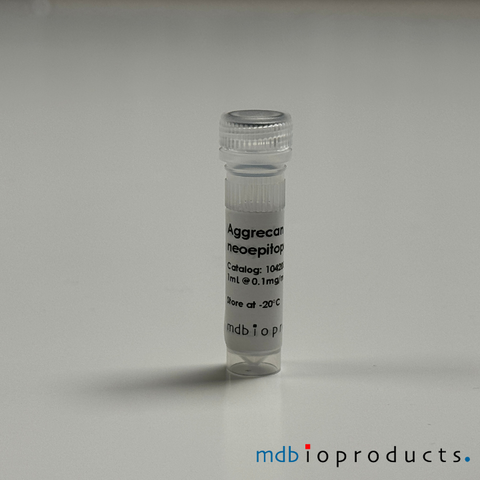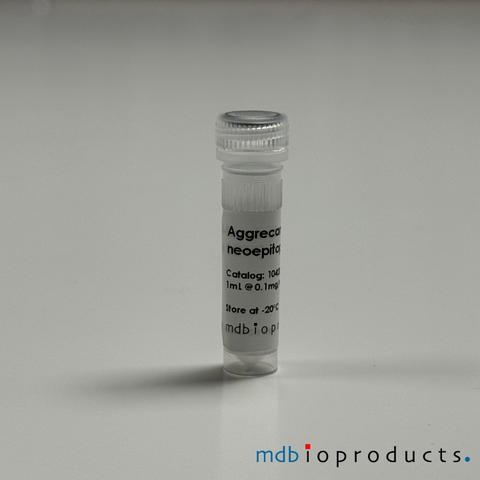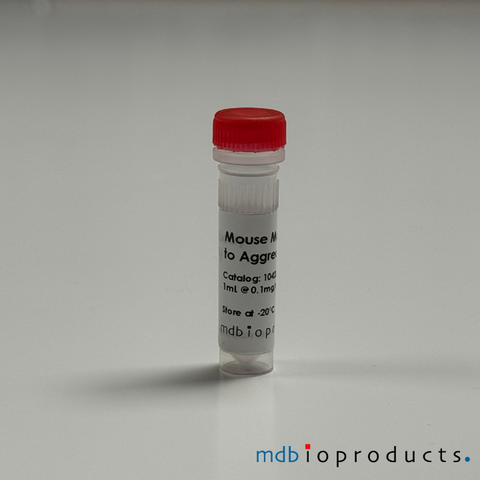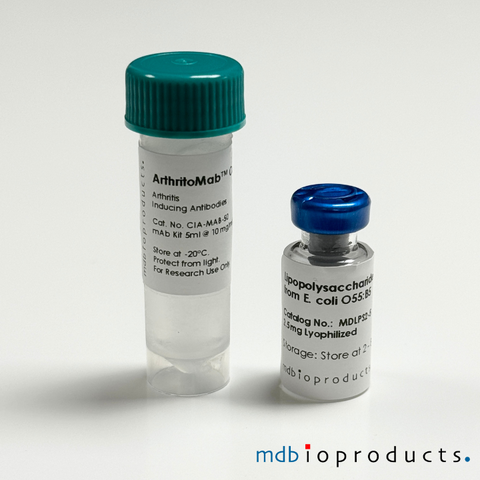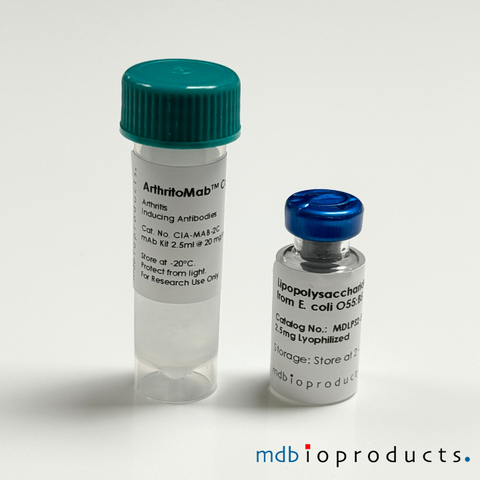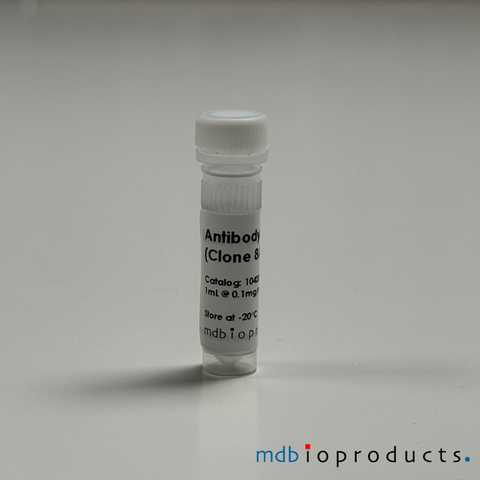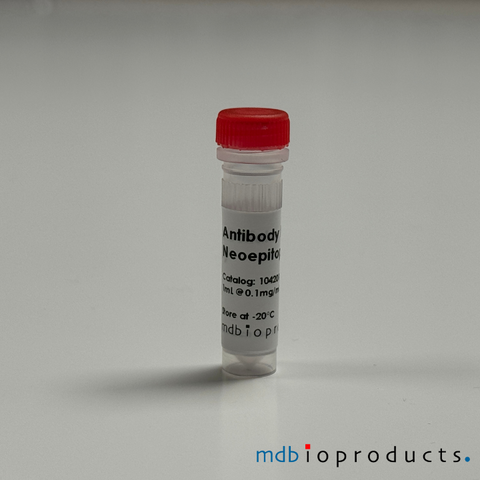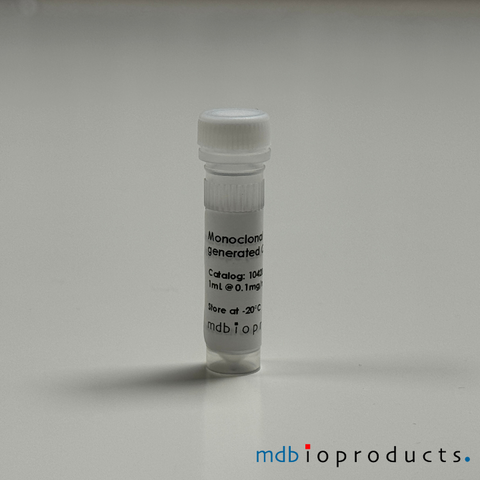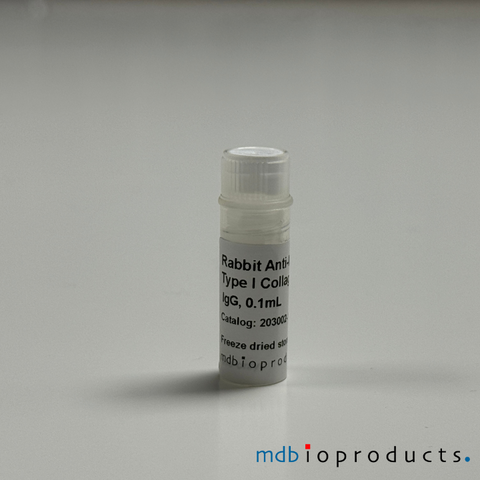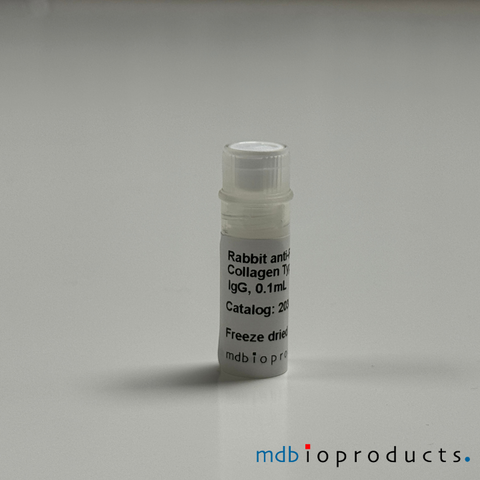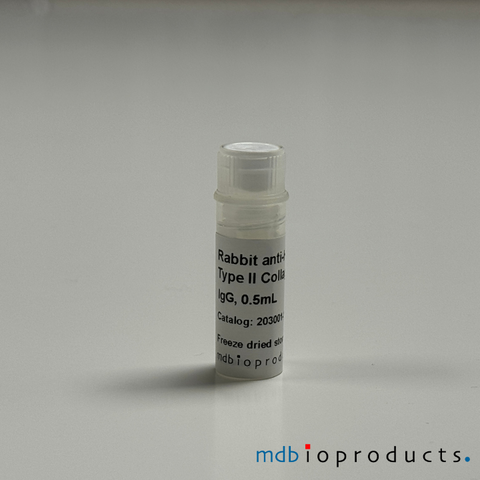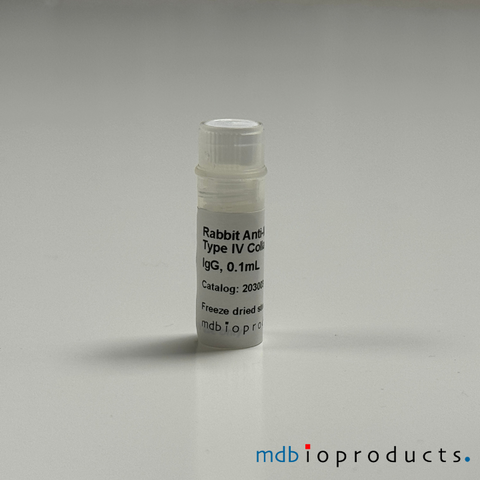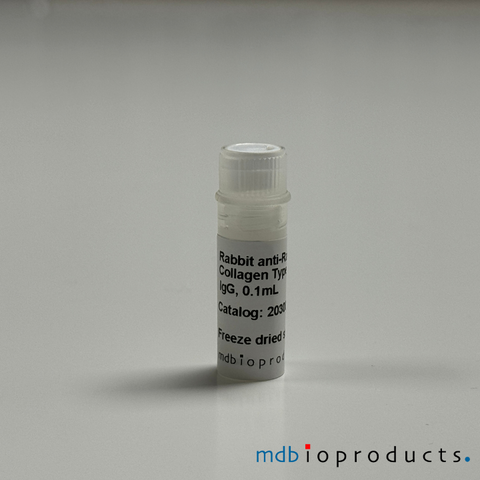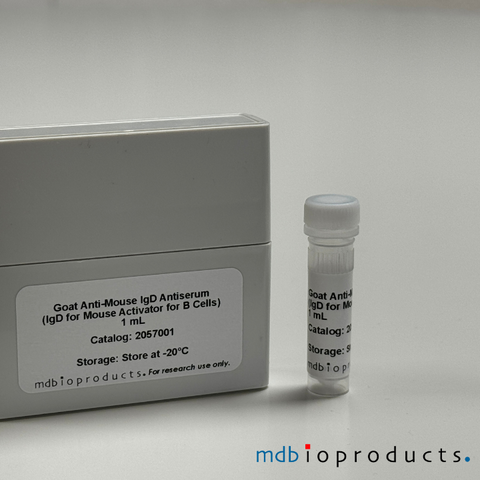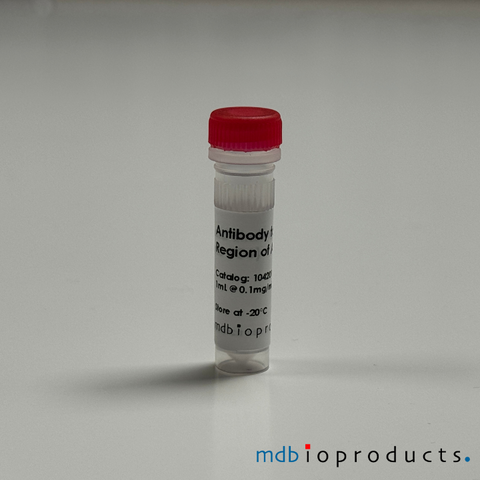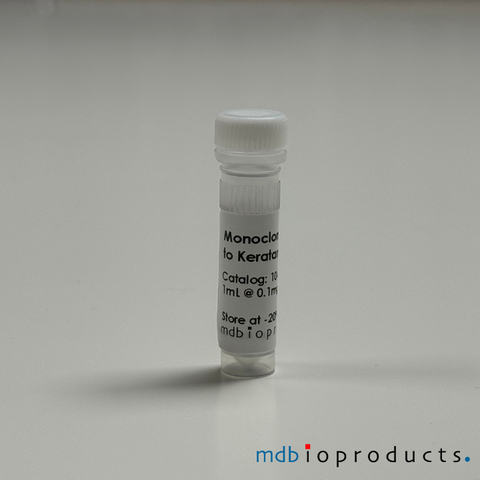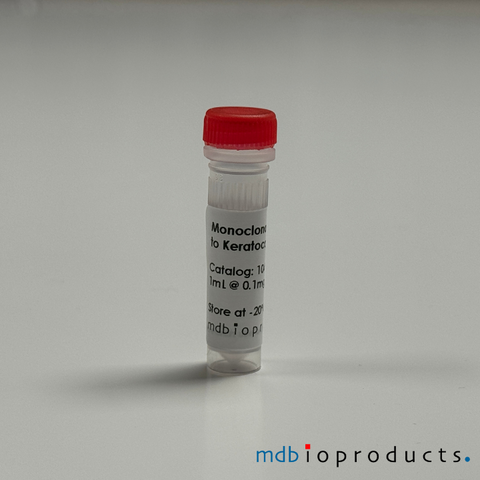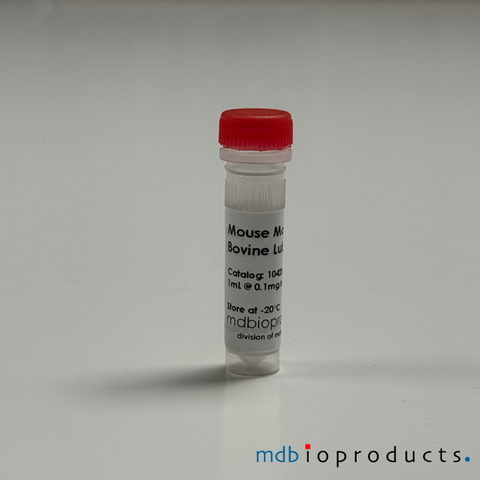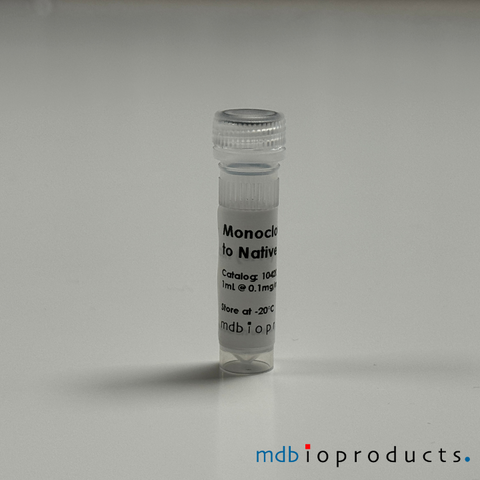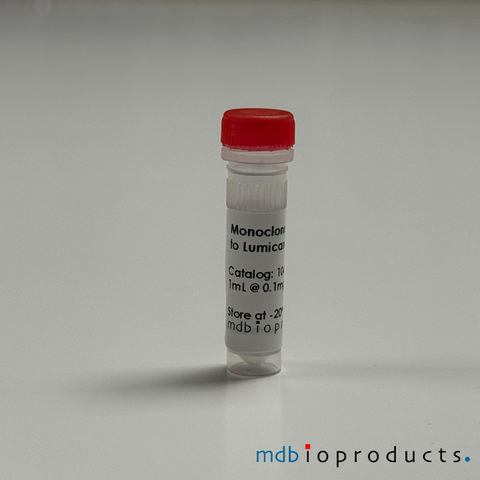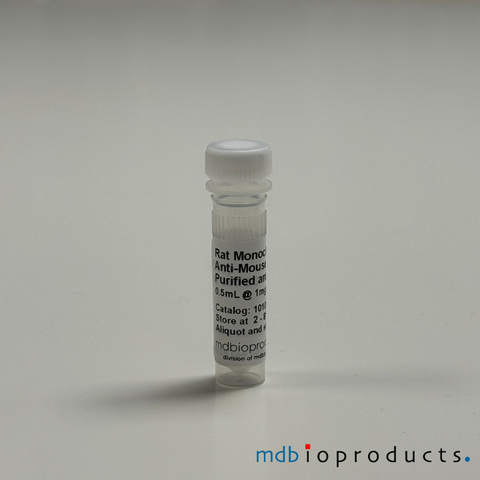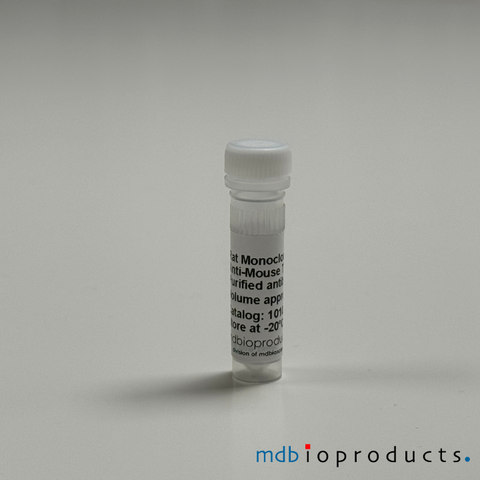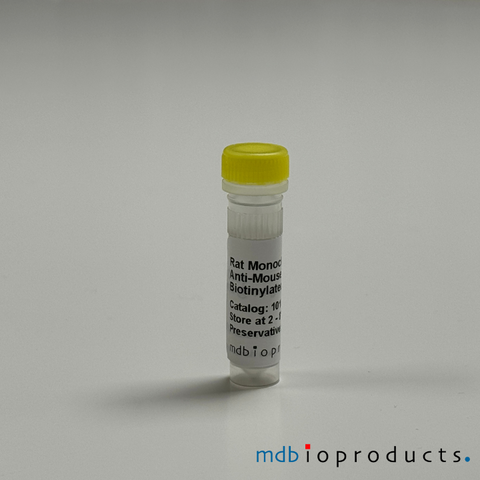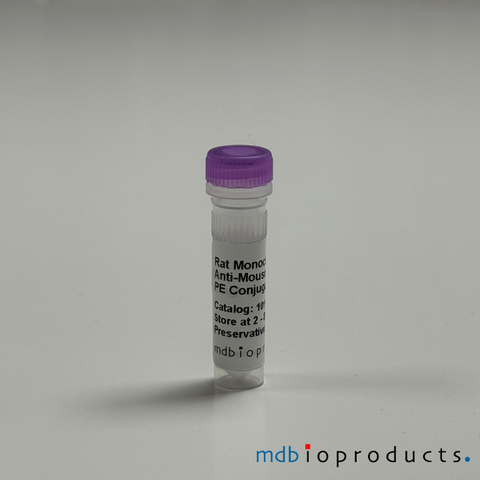T1/ST2 (IL-33R) Mouse, Monoclonal Antibody, FITC, 0.5 mL
Mouse T1/ST2 (IL-33 R) FITC conjugated monoclonal antibody (Clone: DJ8, Host / Isotype Subclass: Rat IgG1, light chain not isotyped) for the identification and purification of murine T helper 2 (Th2)...
Antibodies
101001F
Mouse T1/ST2 (IL-33 R) FITC conjugated monoclonal antibody (Clone: DJ8, Host / Isotype Subclass: Rat IgG1, light chain not isotyped) for the identification and purification of murine T helper 2 (Th2) cells and all forms of murine mast cells.
T1/ST2 (also known as IL-1 R4 or IL-33Ra) is a transmembrane glycoprotein expressed on mast cells and Th2 cells. It is a selective marker for both murine and human Th2 lymphocytes and plays a role in regulating inflammatory responses. IL-33 is a recently identified member of the IL-1 family of cytokines and is involved in Th2 mediated immune responses. IL-33 mediates its biological effects via T1/ST2 binding. The roles of IL-33 and T1/ST2 (IL-33Ra) have been investigated in many immune responses such as allergy, asthma, rheumatoid arthritis and osteoarthritis.
References/Citations:
Prince, N., Peralta Marzal, L. N., Roussin, L., Monnoye, M., Philippe, C., Maximin, E., ... & Perez-Pardo, P. (2025). Mouse strain-specific responses along the gut-brain axis upon fecal microbiota transplantation from children with autism. Gut microbes, 17(1), 2447822.
Yan, C., Kuang, W., Ma, G., Guo, F., Jin, L., Wan, H., ... & Wang, L. (2025). E3 ligase RNF128 restricts A. alternata-induced ILC2 activation and type 2 immune response in the murine lung. Scientific Reports, 15(1), 1193.
Capellmann, S., Kauffmann, M., Arock, M., & Huber, M. (2024). SR-BI regulates the synergistic mast cell response by modulating the plasma membrane-associated cholesterol pool. European journal of immunology, 54(8), e2350788. https://doi.org/10.1002/eji.202350788
Bartolacci, J. G., Behun, M. N., Warunek, J. P., Li, T., Sahu, A., Dwyer, G. K., Lucas, A., Rong, J., Ambrosio, F., Turnquist, H. R., & Badylak, S. F. (2024). Matrix-bound nanovesicle-associated IL-33 supports functional recovery after skeletal muscle injury by initiating a pro-regenerative macrophage phenotypic transition. NPJ Regenerative medicine, 9(1), 7. https://doi.org/10.1038/s41536-024-00346-2
Gurram, R. K., Wei, D., Yu, Q., Butcher, M. J., Chen, X., Cui, K., ... & Zhu, J. (2023). Crosstalk between ILC2s and Th2 cells varies among mouse models. Cell Reports, 42(2).
Ferreira, A. C., Szeto, A. C., Clark, P. A., Crisp, A., Kozik, P., Jolin, H. E., & McKenzie, A. N. (2023). Neuroprotective protein ADNP-dependent histone remodeling complex promotes T helper 2 immune cell differentiation. Immunity.
Sheikh, A., Lu, J., Melese, E., Seo, J. H., & Abraham, N. (2022). IL‐7 induces type 2 cytokine response in lung ILC2s and regulates GATA3 and CD25 expression. Journal of Leukocyte Biology
Pelgrim, C. E., van Ark, I., van Berkum, R. E., Schuitemaker-Borneman, A. M., Flier, I., Leusink-Muis, T., ... & Kraneveld, A. D. (2022). Effects of a nutritional intervention on impaired behavior and cognitive function in an emphysematous murine model of COPD with endotoxin-induced lung inflammation. Frontiers in nutrition, 9, 1010989.
Ye, L., Jin, K., Liao, Z., Xiao, Z., Xu, H., Lin, X., ... & Yu, X. (2022). Hypoxia-reprogrammed regulatory group 2 innate lymphoid cells promote immunosuppression in pancreatic cancer. EBioMedicine, 79, 104016.
Huang, Y., Li, X., Zhu, L., Huang, C., Chen, W., Ling, Z., ... & Zhang, Y. (2022). Thrombin cleaves IL‐33 and modulates IL‐33‐activated allergic lung inflammation. Allergy, 77(7), 2104-2120.
Lu, J. C. L. (2022). Transcriptional regulation of type 2 innate lymphoid cells by interleukin-7 receptor signaling (Doctoral dissertation, University of British Columbia).
Chen, W., Lai, D., Li, Y., Wang, X., Pan, Y., Fang, X., ... & Shu, Q. (2022). Neuronal-Activated ILC2s Promote IL-17A Production in Lung gd T Cells During Sepsis. Immune Dysfunction: An Update of New Immune Cell Subsets and Cytokines in Sepsis.
O’Leary, C. E., Sbierski-Kind, J., Kotas, M. E., Wagner, J. C., Liang, H. E., Schroeder, A. W., ... & Locksley, R. M. (2022). Bile acid–sensitive tuft cells regulate biliary neutrophil influx. Science Immunology, 7(69), eabj1080.
Chen, W., Lai, D., Li, Y., Wang, X., Pan, Y., Fang, X., ... & Shu, Q. (2022). Neuronal-Activated ILC2s Promote IL-17A Production in Lung gd T Cells During Sepsis. Immune Dysfunction: An Update of New Immune Cell Subsets and Cytokines in Sepsis.
Szklany, K., Engen, P. A., Naqib, A., Green, S. J., Keshavarzian, A., Lopez Rincon, A., ... & Kraneveld, A. D. (2021). Dietary Supplementation throughout Life with Non-Digestible Oligosaccharides and/or n-3 Poly-Unsaturated Fatty Acids in Healthy Mice Modulates the Gut–Immune System–Brain Axis. Nutrients, 14(1), 173.
Nono, J. K., Mpotje, T., Mosala, P., Aziz, N. A., Musaigwa, F., Hlaka, L., ... & Brombacher, F. (2021). Treatment of Schistosoma mansoni Infected Mice Renders Them Less Susceptible to Reinfection. Frontiers in Immunology, 12, 748387-748387.
Williams, C. M., Roy, S., Califano, D., McKenzie, A. N., Metzger, D. W., & Furuya, Y. (2021). The Interleukin-33–Group 2 Innate Lymphoid Cell Axis Represents a Potential Adjuvant Target To Increase the Cross-Protective Efficacy of Influenza Vaccine. Journal of Virology, 95(22), e00598-21.
Iijima, K., Kobayashi, T., Matsumoto, K., Ohara, K., Kita, H., & Drake, L. Y. (2021). Transient IL-33 upregulation in neonatal mouse lung promotes acute but not chronic type 2 immune responses induced by allergen later in life. Plos one, 16(5), e0252199.
Kamijo, S., Hara, M., Suzuki, M., Nakae, S., Ogawa, H., Okumura, K., & Takai, T. (2021). Innate IL-17A enhances IL-33-independent skin eosinophilia and IgE response on subcutaneous papain sensitization. Journal of Investigative Dermatology, 141(1), 105-113
Ferreira, A. C., Szeto, A. C., Heycock, M. W., Clark, P. A., Walker, J. A., Crisp, A., ... & McKenzie, A. N. (2021). RORα is a critical checkpoint for T cell and ILC2 commitment in the embryonic thymus. Nature Immunology, 1-13.
Saunders, S. P., Floudas, A., Moran, T., Byrne, C. M., Rooney, M. D., Fahy, C. M., ... & Schwartz, C. (2020). Dysregulated skin barrier function in Tmem79 mutant mice promotes IL-17A-dependent spontaneous skin and lung inflammation. Allergy, 75(12), 3216-3227.
Aparicio-Domingo, P., Cannelle, H., Buechler, M. B., Nguyen, S., Kallert, S. M., Favre, S., ... & Pinschewer, D. D. (2020). Fibroblast-derived IL-33 is dispensable for lymph node homeostasis but critical for CD8 T-cell responses to acute and chronic viral infection. European Journal of Immunology.
Feng, X., Zhao, C., Li, L., Feng, J., He, W., Shi, T., ... & Su, X. (2020). iNKT cells with high PLZF expression are recruited into the lung via CCL21-CCR7 signaling to facilitate the development of asthma tolerance in mice. European Journal of Immunology.
Zhang, K., Jin, Y., Lai, D., Wang, J., Wang, Y., Wu, X., ... & Wilson, M. (2020). RAGE-induced ILC2 expansion in acute lung injury due to haemorrhagic shock. Thorax.
Romera-Hernández, M., Mathä, L., Steer, C. A., Ghaedi, M., & Takei, F. (2019). Identification of Group 2 Innate Lymphoid Cells in Mouse Lung, Liver, Small Intestine, Bone Marrow, and Mediastial and Mesenteric Lymph Nodes. Current Protocols in Immunology, e73.
Sasaki, T., Moro, K., Kubota, T., Kubota, N., Kato, T., Ohno, H., ... & Koyasu, S. (2019). Innate lymphoid cells in the induction of obesity. Cell Reports, 28(1), 202-217.
Abbring, S., Ryan, J. T., Diks, M. A., Hols, G., Garssen, J., & van Esch, B. C. (2019). Suppression of Food Allergic Symptoms by Raw Cow’s Milk in Mice is Retained after Skimming but Abolished after Heating the Milk—A Promising Contribution of Alkaline Phosphatase. Nutrients, 11(7), 1499.
Bosnjak, B., Kazemi, S., Altenburger, L. M., Mokrovic, G., & Epstein, M. M. (2019). Th2-TRMs maintain life-long allergic memory in experimental asthma in mice. Frontiers in immunology, 10, 840.
Mathä, L., Shim, H., Steer, C. A., Yin, Y. H., Martinez-Gonzalez, I., & Takei, F. (2019). Female and male mouse lung group 2 innate lymphoid cells differ in gene expression profiles and cytokine production. PloS one, 14(3), e0214286.
Abbring, S., Ryan, J. T., Diks, M. A., Hols, G., Garssen, J., & van Esch, B. C. (2019). Suppression of Food Allergic Symptoms by Raw Cow’s Milk in Mice is Retained after Skimming but Abolished after Heating the Milk—A Promising Contribution of Alkaline Phosphatase. Nutrients, 11(7), 1499.
Bosnjak, B., Kazemi, S., Altenburger, L. M., Mokrovic, G., & Epstein, M. M. (2019). Th2-TRMs maintain life-long allergic memory in experimental asthma in mice. Frontiers in Immunology, 10, 840.
Mathä, L., Shim, H., Steer, C. A., Yin, Y. H., Martinez-Gonzalez, I., & Takei, F. (2019). Female and male mouse lung group 2 innate lymphoid cells differ in gene expression profiles and cytokine production. PloS one, 14(3), e0214286.
Cui, W., Zhang, W., Yuan, X., Liu, S., Li, M., Niu, J., ... & Li, D. (2019). Vitamin A deficiency execrates Lewis lung carcinoma via induction of type 2 innate lymphoid cells and alternatively activates macrophages. Food Science & Nutrition.
Okubo, Y., Tokumaru, S., Yamamoto, Y., Miyagawa, S. I., Sanjo, H., & Taki, S. (2019). Generation of a common innate lymphoid cell progenitor requires interferon regulatory factor 2. International immunology.
Knolle, M. D., Chin, S. B., Rana, B. M., Englezakis, A., Nakagawa, R., Fallon, P. G., ... & McKenzie, A. N. (2018). MicroRNA-155 protects group 2 innate lymphoid cells from apoptosis to promote type-2 immunity. Frontiers in immunology, 9.
Moldaver, D. M., Bharhani, M. S., Rudulier, C. D., Wattie, J., Inman, M. D., & Larché, M. (2019). Induction of bystander tolerance and immune deviation after Fel d 1 peptide immunotherapy. Journal of Allergy and Clinical Immunology, 143(3), 1087-1099.
Hiraishi, Y., Yamaguchi, S., Yoshizaki, T., Nambu, A., Shimura, E., Takamori, A., ... & Suzukawa, M. (2018). IL-33, IL-25 and TSLP contribute to development of fungal-associated protease-induced innate-type airway inflammation. Scientific reports, 8(1), 18052.
Zhou, Y., Wang, W., Zhao, C., Wang, Y., Wu, H., Sun, X., ... & Zhang, Y. (2018). Prostaglandin E2 Inhibits Group 2 Innate Lymphoid Cell Activation and Allergic Airway Inflammation Through E-Prostanoid 4-Cyclic Adenosine Monophosphate Signaling. Frontiers in immunology, 9, 501.
Bartemes, K., Chen, C. C., Iijima, K., Drake, L., & Kita, H. (2018). IL-33–responsive group 2 innate lymphoid cells are regulated by female sex hormones in the uterus. The Journal of Immunology, 200(1), 229-236.
Ball, D. H., Al-Riyami, L., Harnett, W., & Harnett, M. M. (2018). IL-33/ST2 signalling and crosstalk with FcεRI and TLR4 is targeted by the parasitic worm product, ES-62. Scientific reports, 8(1), 4497.
Ogasawara, T., Kohashi, Y., Ikari, J., Taniguchi, T., Tsuruoka, N., Watanabe-Takano, H., ... & Fukushima, Y. (2018). Allergic TH2 Response Governed by B-Cell Lymphoma 6 Function in Naturally Occurring Memory Phenotype CD4+ T Cells. Frontiers in immunology, 9, 750.
Moldaver, D. M., Bharhani, M. S., Rudulier, C. D., Wattie, J., Inman, M. D., & Larché, M. (2018). Induction of bystander tolerance and immune deviation following Fel d 1 Peptide Immunotherapy. Journal of Allergy and Clinical Immunology.
Shamji, M. H., Temblay, J. N., Cheng, W., Byrne, S. M., Macfarlane, E., Switzer, A. R., ... & Ashton-Rickardt, P. G. (2018). Antiapoptotic serine protease inhibitors contribute to survival of allergenic TH2 cells. Journal of Allergy and Clinical Immunology, 142(2), 569-581.
Califano, D., Furuya, Y., Roberts, S., Avram, D., McKenzie, A. N., & Metzger, D. W. (2018). IFN-γ increases susceptibility to influenza A infection through suppression of group II innate lymphoid cells. Mucosal immunology, 11(1), 209.
Masuda, C., Miyasaka, T., Kawakami, K., Inokuchi, J., Kawano, T., Dobashi‐Okuyama, K., ... & Ohno, I. (2018). Sex‐based differences in CD103+ dendritic cells promote female‐predominant Th2 cytokine production during allergic asthma. Clinical & Experimental Allergy, 48(4), 379-393.
Laman, J. D., Kooistra, S. M., & Clausen, B. E. (2017). Reproducibility issues: avoiding pitfalls in animal inflammation models. In Inflammation (pp. 1-17). Humana Press, New York, NY.
Nascimento, D. C., Melo, P. H., Pineros, A. R., Ferreira, R. G., Colón, D. F., Donate, P. B., ... & Borges, M. C. (2017). IL-33 contributes to sepsis-induced long-term immunosuppression by expanding the regulatory T cell population. Nature communications, 8, 14919.
Madouri, F., Chenuet, P., Beuraud, C., Fauconnier, L., Marchiol, T., Rouxel, N., ... & Marquant, Q. (2017). Protein kinase Cθ controls type 2 innate lymphoid cell and TH2 responses to house dust mite allergen. Journal of Allergy and Clinical Immunology, 139(5), 1650-1666.
Sjöberg, L. C., Nilsson, A. Z., Lei, Y., Gregory, J. A., Adner, M., & Nilsson, G. P. (2017). Interleukin 33 exacerbates antigen driven airway hyperresponsiveness, inflammation and remodeling in a mouse model of asthma. Scientific Reports, 7(1), 4219
Sugita, J., Asada, Y., Ishida, W., Iwamoto, S., Sudo, K., Suto, H., ... & Ohno, T. (2017). Contributions of Interleukin‐33 and TSLP in a papain‐soaked contact lens‐induced mouse conjunctival inflammation model. Immunity, inflammation and disease, 5(4), 515-525.
Schwartz, C., Khan, A. R., Floudas, A., Saunders, S. P., Hams, E., Rodewald, H. R., ... & Fallon, P. G. (2017). ILC2s regulate adaptive Th2 cell functions via PD-L1 checkpoint control. Journal of Experimental Medicine, jem-20170051
Imai, Y., Hosotani, Y., Ishikawa, H., Yasuda, K., Nagai, M., Jitsukawa, O., ... & Yamanishi, K. (2017). Expression of IL-33 in ocular surface epithelium induces atopic keratoconjunctivitis with activation of group 2 innate lymphoid cells in mice. Scientific Reports, 7(1), 10053.
Vonk, M. M., Wagenaar, L., Pieters, R. H., Knippels, L. M., Willemsen, L. E., Smit, J. J., ... & Garssen, J. (2017). The efficacy of oral and subcutaneous antigen-specific immunotherapy in murine cow’s milk-and peanut allergy models. Clinical and translational allergy, 7(1), 35.
Vonk, M. M., Diks, M. A., Wagenaar, L., Smit, J. J., Pieters, R. H., Garssen, J., ... & Knippels, L. M. (2017). Improved efficacy of oral immunotherapy using non-digestible oligosaccharides in a murine cow’s milk allergy model: a potential role for Foxp3+ regulatory T cells. Frontiers in immunology, 8, 1230.
Drube, S., Grimlowski, R., Deppermann, C., Fröbel, J., Kraft, F., Andreas, N., ... & Göpfert, C. (2017). The Neurobeachin-like 2 protein regulates mast cell homeostasis. The Journal of Immunology, ji1700556.
Zoltowska Nilsson, A. M., Lei, Y., Adner, M., & Nilsson, G. P. (2017). Mast cell-dependent IL-33/ST2 signaling is protective against the development of airway hyperresponsiveness in a house dust mite mouse model of asthma. American Journal of Physiology-Lung Cellular and Molecular Physiology, 314(3), L484-L492.
Dullaers, M., Schuijs, M. J., Willart, M., Fierens, K., Van Moorleghem, J., Hammad, H., & Lambrecht, B. N. (2017). House dust mite–driven asthma and allergen-specific T cells depend on B cells when the amount of inhaled allergen is limiting. Journal of Allergy and Clinical Immunology, 140(1), 76-88.
Xi, H., Katschke, K. J., Li, Y., Truong, T., Lee, W. P., Diehl, L., ... & Hackney, J. A. (2016). IL-33 amplifies an innate immune response in the degenerating retina. Journal of Experimental Medicine, 213(2), 189-207
Schulze, B., Piehler, D., Eschke, M., Heyen, L., Protschka, M., Köhler, G., & Alber, G. (2016). Therapeutic expansion of CD4+ FoxP3+ regulatory T cells limits allergic airway inflammation during pulmonary fungal infection. FEMS Pathogens and Disease, 74(4), ftw020.
de Miranda, S. M. N., Wilhelm, T., Huber, M., & Zorn, C. N. (2016). Differential Lyn-dependence of the SHIP1-deficient mast cell phenotype. Cell Communication and Signaling, 14(1), 12.
Vogel, K. U., Bell, L. S., Galloway, A., Ahlfors, H., & Turner, M. (2016). The RNA-binding proteins Zfp36l1 and Zfp36l2 enforce the thymic β-selection checkpoint by limiting DNA damage response signaling and cell cycle progression. The Journal of Immunology, 1600854.
Hams, E., Bermingham, R., Wurlod, F. A., Hogan, A. E., O’Shea, D., Preston, R. J., ... & Fallon, P. G. (2015). The helminth T2 RNase ω1 promotes metabolic homeostasis in an IL-33–and group 2 innate lymphoid cell–dependent mechanism. The FASEB Journal, 30(2), 824-835.
Burrows, K. E., Dumont, C., Thompson, C. L., Catley, M. C., Dixon, K. L., & Marshall, D. (2015). OX40 blockade inhibits house dust mite driven allergic lung inflammation in mice and in vitro allergic responses in humans. European journal of immunology, 45(4), 1116-1128.
Palomo, J., Reverchon, F., Piotet, J., Besnard, A. G., Couturier‐Maillard, A., Maillet, I., ... & Quesniaux, V. F. (2015). Critical role of IL‐33 receptor ST2 in experimental cerebral malaria development. European journal of immunology, 45(5), 1354-1365.
Heger, K., Kober, M., Rieß, D., Drees, C., de Vries, I., Bertossi, A., ... & Schmidt‐Supprian, M. (2015). A novel Cre recombinase reporter mouse strain facilitates selective and efficient infection of primary immune cells with adenoviral vectors. European journal of immunology, 45(6), 1614-1620.
Suzuki, M., Morita, R., Hirata, Y., Shichita, T., & Yoshimura, A. (2015). Spred1, a suppressor of the Ras–ERK pathway, negatively regulates expansion and function of group 2 innate lymphoid cells. The Journal of Immunology, 1500531.
Arshad, M. I., Guihard, P., Danger, Y., Noel, G., Le Seyec, J., Boutet, M. A., ... & Gascan, H. (2015). Oncostatin M induces IL-33 expression in liver endothelial cells in mice and expands ST2+ CD4+ lymphocytes. American Journal of Physiology-Gastrointestinal and Liver Physiology, 309(7), G542-G553.
Shim, D. H., Park, Y. A., Kim, M. J., Hong, J. Y., Baek, J. Y., Kim, K. W., ... & Hong, K. J. (2015). Pandemic influenza virus, pH 1N1, induces asthmatic symptoms via activation of innate lymphoid cells. Pediatric Allergy and Immunology, 26(8), 780-788.
Ahmed, A., & Koma, M. K. (2015). Interleukin‐33 Triggers B 1 Cell Expansion and Its Release of Monocyte/Macrophage Chemoattractants and Growth Factors. Scandinavian journal of immunology, 82(2), 118-124.
Wojno, E. T., Monticelli, L. A., Tran, S. V., Alenghat, T., Osborne, L. C., Thome, J. J., ... & Artis, D. (2015). The prostaglandin D 2 receptor CRTH2 regulates accumulation of group 2 innate lymphoid cells in the inflamed lung. Mucosal immunology, 8(6), 1313.
Zhao, J., Wei, J., Bowser, R. K., Traister, R. S., Fan, M. H., & Zhao, Y. (2015). Focal Adhesion Kinase–Mediated Activation of Glycogen Synthase Kinase 3β Regulates IL-33 Receptor Internalization and IL-33 Signaling. The Journal of Immunology, 194(2), 795-802.
Mathie, S. A., Dixon, K. L., Walker, S. A., Tyrrell, V., Mondhe, M., O'Donnell, V. B., ... & Lloyd, C. M. (2015). Alveolar macrophages are sentinels of murine pulmonary homeostasis following inhaled antigen challenge. Allergy, 70(1), 80-89.
Yu, X., Pappu, R., Ramirez-Carrozzi, V., Ota, N., Caplazi, P., Zhang, J., & Grogan, J. L. (2014). TNF superfamily member TL1A elicits type 2 innate lymphoid cells at mucosal barriers. Mucosal immunology, 7(3), 730-740.
Mirchandani, A. S., Besnard, A. G., Yip, E., Scott, C., Bain, C. C., Cerovic, V., ... & Liew, F. Y. (2014). Type 2 innate lymphoid cells drive CD4+ Th2 cell responses. The Journal of Immunology, 192(5), 2442-2448.
Hams, E., Armstrong, M. E., Barlow, J. L., Saunders, S. P., Schwartz, C., Cooke, G., ... & Fallon, P. G. (2014). IL-25 and type 2 innate lymphoid cells induce pulmonary fibrosis. Proceedings of the National Academy of Sciences, 111(1), 367-372.
Hams, E., Locksley, R. M., McKenzie, A. N., & Fallon, P. G. (2013). Cutting edge: IL-25 elicits innate lymphoid type 2 and type II NKT cells that regulate obesity in mice. The Journal of Immunology, 191(11), 5349-5353.
Kabata, H., Moro, K., Fukunaga, K., Suzuki, Y., Miyata, J., Masaki, K., ... & Asano, K. (2013). Thymic stromal lymphopoietin induces corticosteroid resistance in natural helper cells during airway inflammation. Nature communications, 4.
Nussbaum, J. C., Van Dyken, S. J., von Moltke, J., Cheng, L. E., Mohapatra, A., Molofsky, A. B., ... & Locksley, R. M. (2013). Type 2 innate lymphoid cells control eosinophil homeostasis. Nature, 502(7470), 245-248.
Maazi, H., Shirinbak, S., Boef, L. E., Fallarino, F., Volpi, C., Nawijn, M. C., & Oosterhout, A. J. M. (2013). Cytotoxic T lymphocyte antigen 4‐immunoglobulin G is a potent adjuvant for experimental allergen immunotherapy. Clinical & Experimental Immunology, 172(1), 113-120.
Elsen, L. W. J., Esch, B. C. A. M., Hofman, G. A., Kant, J., Heijning, B. J. M., Garssen, J., & Willemsen, L. E. M. (2013). Dietary long chain n‐3 polyunsaturated fatty acids prevent allergic sensitization to cow's milk protein in mice. Clinical & Experimental Allergy, 43(7), 798-810.
Maazi, H., Shirinbak, S., Boef, L. E., Fallarino, F., Volpi, C., Nawijn, M. C., & Oosterhout, A. J. M. (2013). Cytotoxic T lymphocyte antigen 4‐immunoglobulin G is a potent adjuvant for experimental allergen immunotherapy. Clinical & Experimental Immunology, 172(1), 113-120.
Halim, T. Y., MacLaren, A., Romanish, M. T., Gold, M. J., McNagny, K. M., & Takei, F. (2012). Retinoic-acid-receptor-related orphan nuclear receptor alpha is required for natural helper cell development and allergic inflammation. Immunity, 37(3), 463-474.
Zhao, J., Wei, J., Mialki, R. K., Mallampalli, D. F., Chen, B. B., Coon, T., ... & Zhao, Y. (2012). F-box protein FBXL19-mediated ubiquitination and degradation of the receptor for IL-33 limits pulmonary inflammation. Nature immunology, 13(7), 651-658.
Müller, U., Piehler, D., Stenzel, W., Köhler, G., Frey, O., Held, J., ... & Alber, G. (2012). Lack of IL-4 receptor expression on T helper cells reduces T helper 2 cell polyfunctionality and confers resistance in allergic bronchopulmonary mycosis. Mucosal immunology, 5(3), 299-310.
Halim, T. Y., Krass, R. H., Sun, A. C., & Takei, F. (2012). Lung natural helper cells are a critical source of Th2 cell-type cytokines in protease allergen-induced airway inflammation. Immunity, 36(3), 451-463.
Kim, H. Y., Chang, Y. J., Subramanian, S., Lee, H. H., Albacker, L. A., Matangkasombut, P., & Umetsu, D. T. (2012). Innate lymphoid cells responding to IL-33 mediate airway hyperreactivity independently of adaptive immunity. Journal of Allergy and Clinical Immunology, 129(1), 216-227.
Jiang, H. R., Milovanović, M., Allan, D., Niedbala, W., Besnard, A. G., Fukada, S. Y., ... & Liew, F. Y. (2012). IL‐33 attenuates EAE by suppressing IL‐17 and IFN‐γ production and inducing alternatively activated macrophages. European journal of immunology, 42(7), 1804-1814.
Monticelli, L. A., Sonnenberg, G. F., Abt, M. C., Alenghat, T., Ziegler, C. G., Doering, T. A. & Artis, D. (2011). Innate lymphoid cells promote lung-tissue homeostasis after infection with influenza virus. Nature immunology, 12(11), 1045-1054.
Al-Garawi, A., Fattouh, R., Botelho, F., Walker, T. D., Goncharova, S., Moore, C. L., & Jordana, M. (2011). Influenza A facilitates sensitization to house dust mite in infant mice leading to an asthma phenotype in adulthood. Mucosal immunology, 4(6), 682-694.
Identification of Semaphorin 4B as a Negative Regulator of Basophil-Mediated Immune Responses. Nakagawa, Y et al., J. Immunol. (2011) 186:2881
Contribution of IL-33 to induction and augmentation of experimental allergic conjuctivitis. Matsuba-Kitamura S, et al., International Immunology, May 2010
Eosinophils are dispensable for allergic remodeling and immunity in a model of house dust mite-induced airway disease. Fattouh R, et al. Am J Respir Crit Care Med. 2010 Aug 23.
Contribution of IL-33 to induction and augmentation of experimental allergic conjuctivitis. Matsuba-Kitamura S, et al., International Immunology, May 2010
Interleukin-33 attenuates sepsis by enhancing neutrophil influx to the site of infection. Alves-Filho J, et al. Nature Medicine., 2010; 16(6):2-7.
Activin-A induces regulatory T cells that suppress T helper cell immune responses and protect from allergic airway disease. Semitekolou M, et al. J. Exp. Med., 2009; 206(8):1769-85.
IL-33 reduces the development of atherosclerosis. Ashley M. Miller et al., J. Exp. Med., Feb 2008; 205: 339 - 346.
IL-1beta-driven ST2L expression promotes maturation resistance in rapamycin-conditioned dendritic cells. Turnquist H, et al. Journ. Immunol., 2008; 181(1):62-72.
Osteopontin has a crucial role in allergic airway disease through regulation of dendritic cell subsets. Xanthou G, et al. Nature Medicine. 2007; 13(5):570-80
Soluble ST2 Blocks Interleukin-33 Signaling in Allergic Airway Inflammation. Hiroko Hayakawa et al., J. Biol. Chem., Sep 2007; 282: 26369 - 26380.
Phenotypic differences between Th1 and Th17 cells and negative regulation of Th1 cell differentiation by IL-17. Susumu Nakae et al., J. Leukoc. Biol., May 2007; 81: 1258 - 1268.
Airway Epithelial STAT3 Is Required for Allergic Inflammation in a Murine Model of Asthma. Marina C. Simeone-Penney et al., J. Immunol., May 2007; 178: 6191 - 6199.
CCR4 is a key modulator of innate immune responses. Ness T, et al. Journ. of immunol., 2006; 177(11): 7531-9.
IFN- Induces Apoptosis in Developing Mast Cells, Meredith N. Mann-Chandler et al., J. Immunol., Sep 2005; 175: 3000 - 3005.
Identification of mast cell progenitors in adult mice, Ching-Cheng Chen et al., PNAS, Aug 2005; 102: 11408 - 11413.
Predominance of Th2 response in human abdominal aortic aneurysm: Mistaken identity for IL-4-producing NK and NKT cells? Chan WL, et al. Cellular Immun (2005) 233:109-114
Changes in systemic type 1 and type 2 immunity in normal pregnancy and pre-eclampsia may be mediated by natural killer cells Borzychowski, A.M. et al., Eur J Immunol (2005) 35:3054-3063.
Product Insert (PDF) - Informational use only. Please refer to insert included with product.
Data/Specifications:
- Rat anti-Mouse T1/ST2 FITC-conjugated mAb
- Clone: DJ8
- Host / Isotype Subclass: Rat IgG1 (light chain not isotyped)
- Form: The antibody is supplied in PBS, with 0.1% sodium azide as preservative and purified over protein G-sepharose. The characteristics of each lot are tested by FACS analysis with bone marrow derived mast cells.
- Specificity: This clone recognizes the membrane anchored murine T1M protein on the surface of T helper 2 cells and mast cells. T1M appears on fetal blood derived mast cell progenitors before they express the Fce RI, on IL-3-dependent bone marrow derived mast cells and on mature peritoneal mast cells. The antibody detects T1S protein consisting only of the extracellular portion of the protein, which is secreted from growth factor and proinflammatory cytokine-stimulated murine fibroblasts.
- Immunogen: Eukariotically expressed fusion protein of mouse T1 ectodomain and human immunoglobulin Fc domain.




